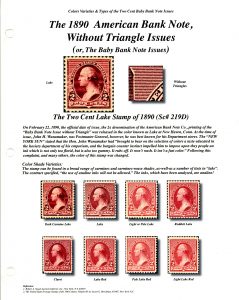Philatelic Society of Lancaster County
The James Buchanan Chapter #173 of the American Philatelic Society
Chapter 118 of the American Topical Association
Exhibit: Color Varieties and Types of the Two Cents Baby Bank Note Issues 1890-1903, by Hal Klein
 This postal history Exhibit presents a study of the Two Cent Small Bank Note Issue of 1890-1903, otherwise known as the “The Two Cent Baby Bank Note Issue” – showing the transition from the privatized printing of U.S. postage stamps to the first U.S. Government printed postage stamps by the Bureau of Engraving and Printing; showing the BEPs addition of four “triangle types” to the original American Bank Note Company design.
This postal history Exhibit presents a study of the Two Cent Small Bank Note Issue of 1890-1903, otherwise known as the “The Two Cent Baby Bank Note Issue” – showing the transition from the privatized printing of U.S. postage stamps to the first U.S. Government printed postage stamps by the Bureau of Engraving and Printing; showing the BEPs addition of four “triangle types” to the original American Bank Note Company design.
The Exhibit demonstrates the ever changing complex color pallet (tones, tints and shades) of both the “1890 Two Cent Baby Bank Note (without triangle)” definitive issue and twenty-five (25) types of the “Two Cent Triangle of 1894–98 (with triangle)” Bureau of Engraving and Printing issues, all with related Scott®-numbers, where 100+ shades and tints are known on just one Scott® variety. The “Encyclopedia of the Colors of United States Postage Stamps”® by R.H. White was the primary guide used for the matching and definition of colors, while additional stamp colors were matched to Robert A. Siegel Auction Galleries® and the Pantone®, 4-Color Process Guide, Uncoated.
In addition to the extensive color study, this postal history Exhibit demonstrates: plate varieties and errors; domestic and foreign mail rates; rare to common pre-electric model Machine cancellations; single- and duplex-handstamp cancellations, including Mail Wagon Collection & Distribution cancellations, and more, at a time when the post office was trying to improve and modernize its printing, mailing and distribution systems. Many items show Experimental and Discovery use.
The postal history of this period is rich, extensive and reflective of the mores of that period in our nation. The post-Civil War period found retail and wholesale companies using more and more direct mail advertising as a cheap way to reach customers and sell product. Racist illustrations were nothing new on advertising covers in the late 1850s, however their usage exploded after the Civil War, especially in the ‘Jim Crow’ South.
Racist advertising on late 19th century envelopes and postal cards, depicted African Americans as laborers, maids or bad children, usually caricatures with big lips, bulging eyes, eating watermelons, running from alligators, and speaking in black dialect; these were just a few of the more popular illustrations depicted. The practice decreased by the early 20th century and basically ceased after the civil rights movement of the 1960s. The racist advertising covers displayed in this Exhibit are for education and are designated for donation to the ‘Jim Crow Museum of Racist Memorabilia’ at Ferris State University in Big Rapids, Michigan.
